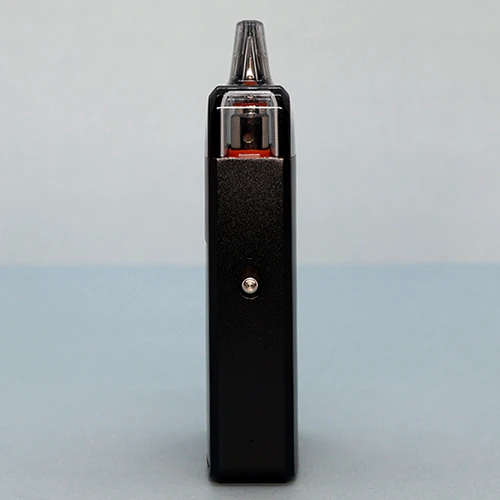VAPORESSO ECO NANO PRO

4.5
Outstanding
VAPORESSO ECO NANO 2

4.0
Excellent
PROS
- Small, lightweight, and discreet
- Brushed metal finish feels solid and robust
- Simple and uncomplicated to use
- Inexpensive alternatives to single-use vapes
- Adjustable vaping modes (Eco Nano Pro)
- Loose draw and medium throat hit similar to disposables
- Large 6ml pods mean fewer refills are needed
- E-liquid is easily visible down to the last drop
- Pods/coils last for more than two weeks
- Efficient Corex coils produce good flavor
CONS
- Only one pod included with each of the kits
- Both vapes occasionally suffer from spit-back
- May be too simple for existing pod vapers
The bottom line
After reading a bit about the Eco Nano 2 and Eco Nano Pro before they arrived for review, I have to admit I wasn’t expecting to like them very much. I have been buying and using increasingly complex pod vapes for years and enjoy being able to tweak every setting to suit my needs. After two weeks of use, I don’t mind admitting I was at least partially wrong.
The 6ml pods are a major selling point (unfortunately, not for users in TPD countries), flavor reproduction and throat hit are solid, especially from the Nano Pro in Power Mode, and battery life is respectable with both devices offering around two days of use per charge in Eco Mode.
Having more than one pod in the kits would probably have been appreciated by most users, particularly new ones, and the occasional spit-back through the mouthpiece can be annoying. I also missed the ability to adjust the airflow by increments, but that’s more likely due to it being what I’m used to, not because I particularly needed to.
Existing pod or pod mod vapers might not find that they offer enough adjustability, but for the type of user they are aimed at, i.e. users of disposables wanting to switch, they are both simple but solid and usable devices.
SAVE 12%
CODE: VERSED
Following their recent launch of the XROS 4 Nano, VAPORESSO has not only doubled but tripled up on their ‘Nano’ game with the release of two new, square form-factor vapes, the Eco Nano 2 and the Eco Nano Pro.
These two devices are an upgrade and update to the original Eco Nano: the Nano 2 being a direct update, while the Nano Pro is more of a better, younger brother. Just like the original Eco Nano, both are aimed at users who want to transition easily from using disposable vapes to using refillable vapes.
Each device features a 1000mAh battery, agreeably large 6ml pods with resistances ranging from 0.6Ω to 1.2Ω, and VAPORESSO’s reliable Corex coils and Axon chips inside. While the Pro also features adjustable vaping modes, they appear to be simple, uncomplicated devices. But are they too simple, or has VAPORESSO come up with two perfect transition vapes?
These devices were sent to me directly by VAPORESSO for the purpose of this review. However, this does not in any way affect my thoughts, opinions, or ratings of these devices.
Eco Nano 2
- 1 x Eco Nano 2 device
- 1 x 0.6Ω Nano Mesh Pod (pre-installed)
- 1 x User Manual
Eco Nano Pro
- 1 x Eco Nano Pro device
- 1 x 0.6Ω Nano Lush Mesh Pod (pre-installed)
- 1 x User Manual
Eco Nano 2
- Size: 77mm x 44.7mm x 18mm
- Weight: 54g
- Pod Capacity: 6ml (2ml TPD)
- Draw activated
- MTL/RDL draw
- Battery Size: 1000mAh
- Charging: 1A Type-C
Eco Nano Pro
- Size: 87.8mm x 44.7mm x 18mm
- Weight: 54g
- Pod Capacity: 6ml (2ml TPD)
- Draw activated
- MTL/RDL draw
- Battery Size: 1000mAh
- Charging: 1A Type-C
Design & Build Quality
 ECO NANO PRO (left) and ECO NANO 2 (right)
ECO NANO PRO (left) and ECO NANO 2 (right)




VAPORESSO applies the “Nano” tag to all of their short, square devices, and the Eco Nano 2 and Eco Nano Pro sit firmly within that family of vapes. Almost every vape brand offers this type of square device, and they aren’t anything new, but these stand out for the full-width 6ml pod sitting proudly on top. I’ll look at the pod in more detail later, but I think it’s safe to say that it will be, as it was in the original Eco Nano, a major selling point for many users.
The body of both Eco Nano vapes is made from brushed metal, likely aluminum or zinc alloy. The larger of the two, the 75g Pro, measures a compact 87.8mm x 44.7mm x 18mm, and the Nano 2 is just a touch shorter at 77mm but otherwise has the same dimensions.
Both are pretty small, but the Eco Nano 2 in particular feels tiny and is also very light at just 62g. Despite their small size and low weight, both vapes feel pretty solid in your hand. There’s very little give in the metal and the brushed finish makes them feel good quality.
 VAPORESSO ECO NANO Pro
VAPORESSO ECO NANO Pro VAPORESSO ECO NANO Pro
VAPORESSO ECO NANO Pro VAPORESSO ECO NANO Pro
VAPORESSO ECO NANO Pro VAPORESSO ECO NANO Pro
VAPORESSO ECO NANO Pro VAPORESSO ECO NANO 2
VAPORESSO ECO NANO 2 VAPORESSO ECO NANO 2
VAPORESSO ECO NANO 2 VAPORESSO ECO NANO 2
VAPORESSO ECO NANO 2
There are eight colors to choose from in the Pro, ranging from black and grey to blue, red, and green. The Nano 2 color options are perhaps slightly “jazzier” with orange, bright blue, and purple complimenting the more subtle black, grey, and silver versions. You can see a full list of the colors for each below.
The Pro has a large, colorful screen covering the front of the front face, and the Nano 2 has a small panel for the LED battery indicator lights, but other than the mode switch on the side of the Pro, and a bit of branding on both, there is very little else to break up their clean and sharp designs.
Eco Nano 2 Colors
- Sunkissed Amber
- Blossom Pink
- Sky Blue
- Misty Green
- Mistic Purple
- Cali Blue
- Urban Grey
- Night Dark
- Pristine White
Eco Nano Pro Colors
- Black
- Coffee Brown
- Gunmetal
- Silver
- Ocean Blue
- Coral Red
- Sakura Pink
- Emerald Green
Pods

One of the things that set these VAPORESSO devices apart from most other pod vapes is the 6ml e-liquid capacity. There are a few pod vapes available with a 5ml capacity, including the VAPORESSO LUXE 2, but 2-3ml is far more common. The company suggests that these pods, when full, will last for up to 18,000 puffs (Eco Nano 2) or 25,000 puffs (Nano Pro), but I’d guess those figures are unlikely outside of a test lab. Nevertheless, a 6ml pod is a great feature and is sure to be warmly welcomed by most users.
You only get one 0.6Ω pod in each of the kits, which is a little bit disappointing. Most modern pod vapes come with a second pod in the box, usually with a different resistance so that you can better tailor the vaping experience to your taste. Considering the lack of adjustability elsewhere, giving us the choice of two resistances out of the box would have been nice.
The pod included with the Pro is one of VAPORESSO’s new Nano Lush Mesh pods, designed to boost flavor by utilizing an improved cotton wick structure in the Corex coil. You also have the option to use any of the standard Nano pods (the type included with the Nano 2 device) with resistances ranging from 0.6Ω to 1.2Ω. The Lush Mesh version is currently only available in 0.6Ω.

All of the Eco Nano pods are bottom-fill, and while I prefer a top-fill pod for being easier to use and generally more leak-resistant, the Nano pods seem pretty good. The fill port is large and the silicone bung feels secure, so filling has been easy and mostly mess-free. Every pod can of course leak, either through being left unused for days or when the coil stops working efficiently, but I experienced no more than a few small spots of leaked liquid in two weeks of use.
The pods are only very slightly tinted and the whole e-liquid reservoir sits above the body of the device, making it very easy to see how much of that 6ml capacity is left in the tank. That might only seem like a small thing, but it’s often small quality-of-life design choices like this that can make or break the pod vaping experience.
Features

The Eco Nano Pro and Eco Nano 2 have been designed to ease the transition from disposables to refillable vapes. As such, neither is very complex to use and features have been kept to a minimum. Calling them “basic” feels wrong as they are well made and have clearly been well thought out, but both are about as simple to use as pod vapes get these days.
The Eco Nano 2 epitomizes this simplicity. With no display other than simple LEDs, no adjustable wattage, and no way to adjust the airflow, this truly is a fill-and-go vape. The Pro offers a little more by way of adjustability, allowing you to choose between Eco and Power modes at the flick of a switch. As far as I can tell, the main difference between the two modes is slightly increased airflow in Power mode, although I assume that wattage is also boosted.

The Eco Nano Pro also features that previously-mentioned large display taking up almost the whole of the front face. This activates when changing mode or drawing on the device and displays the current mode, battery level, and a little UFO graphic.
Both Eco Nano devices use VAPORESSO’s clever Axon chip, which adds several unseen features designed to improve vape performance. The most notable is Pulse Mode, which modulates power through the coil for consistent vapor and flavor production throughout each puff.
Battery Life & Charging

A capacity of 1000mAh is about average in today’s small pod vapes and that’s exactly what you get in the Eco Nano 2 and Pro. If you’re coming from using a rechargeable disposable, which probably only has 650mAh, that’s a significant upgrade. Of course, 1300mAh would be better, but that isn’t the standard in this type of device.
Charging is carried out through the USB Type-C port on the bottom of the devices. Sadly, they only support 1A charging, so don’t expect to go from empty to full in twenty minutes. During my two weeks of testing, the recharge time averaged around an hour. Just as with most disposables, there is no USB cable included with these kits, but there can be few households in 2024 that don’t have at least one unused USB-C cable knocking around in a drawer.
Battery life varied between devices and the modes used on the Pro. The best I got out of the Nano 2 was two days and the Pro lasted for a similar period in Eco Mode.
When the Pro was switched up to Power Mode use time dropped considerably, but I was still occasionally able to get a day and a half out of a full charge. Due to the large 6ml pod, this often worked out to one pod per charge, which is likely to be similar to most user’s experience considering the lack of adjustability.
The remaining battery power is displayed on the large screen on the Eco Nano Pro but on the Nano 2, you have to rely on the less precise LED indicator. The lights denote:
- One light: Under 25% remaining
- Two lights: 25-50% remaining
- Three lights: 50-75% remaining
- Four lights: 75-100% remaining
Performance

The Eco Nano 2 and Eco Nano Pro can only really be considered loose MTL vapes. The lack of pods below 0.6Ω, no adjustable airflow, and no high power setting means DL and even RDL vaping are not a realistic option. It’s probably better to think about these devices as refillable and rechargeable disposables and use them in a way that is appropriate for that type of vape.
With that in mind, I decided to test them with a 50/50 nic salt liquid and also with a 70/30 freebase liquid, both of which are suitable for MTL vaping. Flavor reproduction was decent from both vapes, but better with the Pro in Power Mode, unsurprisingly. I can’t say the flavors are the best I’ve ever experienced from a pod vape, but it wasn’t a disappointing experience.
The draw is quite loose for MTL, but as these are designed to replace disposables rather than cigarettes, a looser draw (as is common in Elf Bar, Geek Bar, and other single-use devices) makes sense. The throat hit from the Pro is satisfying, but less so from the Nano 2. Neither is very intense, but that’s not unexpected for these relatively low-power devices.
I did experience a bit of spit-back (small amounts of e-liquid being sucked into the mouth when you draw) at times. This happened more often with the Nano 2 and when using the Pro in Eco Mode, but also a few times in Power Mode. This is perhaps due to the fairly short mouthpiece and chimney, but could also be caused by insufficient heat generated by the coil to vaporize the e-liquid.
Verdict
After reading a bit about the Eco Nano 2 and Eco Nano Pro before they arrived for review, I have to admit I wasn’t expecting to like them very much. I have been buying and using increasingly complex pod vapes for years and enjoy being able to tweak every setting to suit my needs. After two weeks of use, I don’t mind admitting I was at least partially wrong.
The 6ml pods are a major selling point (unfortunately, not for users in TPD countries), flavor reproduction and throat hit are solid, especially from the Nano Pro in Power Mode, and battery life is respectable with both devices offering around two days of use per charge in Eco Mode.
Having more than one pod in the kits would probably have been appreciated by most users, particularly new ones, and the occasional spit-back through the mouthpiece can be annoying. I also missed the ability to adjust the airflow by increments, but that’s more likely due to it being what I’m used to, not because I particularly needed to.
Existing pod or pod mod vapers might not find that they offer enough adjustability, but for the type of user they are aimed at, i.e. users of disposables wanting to switch, they are both simple but solid and usable devices.
SAVE 12%
CODE: VERSED










Add comment